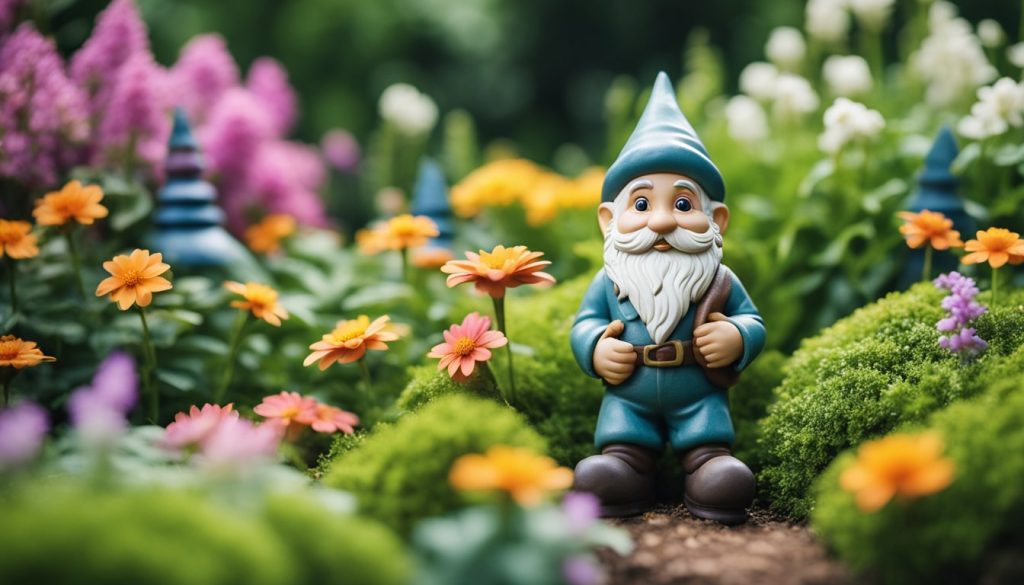Have you ever thought about what gnomes mean spiritually? These tiny, mystical beings often appear in gardens or folklore, but their significance goes much deeper.
In many cultures, gnomes symbolize wisdom, protection, and a profound connection to the earth. They are often regarded as guardians of hidden treasures and protectors of the natural world.

Folklore tells us that gnomes are mythical creatures closely tied to the earth element. They are believed to be earth elementals, representing stability, grounding, and nurturing energy.
Their small stature and elusive nature convey a sense of humility and respect for the natural environment.
Throughout history, gnomes have made their mark in various traditions and stories. Their cultural impact continues to inspire, filling our gardens and literature with tales of their magical attributes.
Key Takeaways
- Gnomes symbolize wisdom, protection, and a connection to the earth.
- Seen as earth elementals, they represent stability and nurturing energy.
- Their cultural impact and mystical attributes continue to inspire today.
Historical Context and Origins

Gnomes have a rich history that spans across various cultures and eras. Let’s explore where these mystical beings come from and how they have evolved over time to become symbols of magic and tradition.
Mythological Roots of Gnomes
Gnomes initially come from ancient European mythology. Alchemists like Paracelsus in the 16th century believed they were earth elementals. Gnomes were thought to live underground, protecting treasures and minerals.
In Roman and Greek mythology, small earth-dwelling beings influenced the gnomes’ archetype. These early myths shaped the modern perception of gnomes as guardians of the natural world.
Gnomes in Folklore and Legend
Gnomes also appear in the folklore of various European countries. In Germanic traditions, they are called “gnom” or “gnomus” and are depicted as small, bearded men who guard hidden treasures.
In Scandinavian legends, they are often associated with the tomte or nisse, household spirits who help with chores but can be mischievous. These stories emphasize their roles as protectors of the homestead and nature.
Evolution of Gnome Depictions
Over centuries, gnome depictions have evolved significantly. In medieval art, they were sometimes sinister, but during the Renaissance, they took on more benign, wise appearances.
The modern garden gnome arose in the 19th century in Germany. These figurines spread across Europe and North America, symbolizing luck and protection for one’s garden.
Gnomes today are often seen in popular media like books, movies, and TV shows. They continue to be symbols of magic, wisdom, and a deep connection to the earth.
Symbolic Meanings of Gnomes
Gnomes symbolize various aspects of the earth, protection, wisdom, and prosperity. The following subsections break down their significance in these areas.
Gnomes as Earth Elementals
Gnomes are widely regarded as representations of earth elementals. Their connection to the earth signifies stability, grounding, and a deep bond with nature.
They are often depicted as small, earthy beings who live in harmony with the soil and plants. Through this symbiotic relationship, they embody fertility of the soil and the nurturing elements of the earth.
Their earthy associations make them symbols of aspects such as fertility, abundance, and nurturing.
Protectors of Nature and Gardens
Often, gnomes are seen as the protectors of gardens and natural spaces. Their role in folklore is that of a steward or guardian who ensures the health and vitality of plants and wildlife.
By placing gnome statues in gardens, people believe they bring protection and good energy to the space.
They’re known to ward off harmful pests and other negative influences, acting as the guardians of nature’s treasures. This protective quality makes them popular symbols of care and guardianship in nature.
Gnomes and Prosperity
Gnomes are also frequently associated with prosperity and good fortune. Their connection to the earth element enhances their association with material wealth and success.
In many cultures, having a gnome in your home or garden is thought to attract wealth and fertility to the land.
These small beings are symbols of luck, prosperity, and positive growth. People often believe that gnomes help in manifesting wealth and abundance simply by their presence.
Guardianship and Wisdom
Gnomes are symbols of guardianship and wisdom. In folklore, they are characterized as wise and ancient beings with deep knowledge of the earth and nature’s secrets.
Their wisdom manifests in their protective actions and their instinctual care for the environment.
Gnomes often serve as advisors or keepers of hidden knowledge in various stories. This makes them fitting symbols of wisdom and protection, valuable qualities in any setting.
Gnomes in the Natural World

Gnomes play a significant role in the natural world, fostering connections with plants and animals, supporting ecosystem stability, and existing deeply within the underground realm.
Connection with Plants and Animals
Gnomes are often seen as the caretakers of gardens and forests. They help plants grow by nurturing the soil and ensuring that roots have the nutrients they need.
Close relationships with animals, especially small woodland creatures, allow them to maintain balance in their environments.
Imagine a garden where gnomes encourage bees to pollinate flowers and earthworms to aerate the soil.
These earth elementals are believed to communicate with plants and animals, understanding their needs.
By being in tune with the natural rhythms, gnomes act as guardians of the earth, ensuring that both flora and fauna thrive. Their presence is seen as a sign of environmental health and harmony.
Gnomes and the Stability of Ecosystems
Maintaining stability in an ecosystem is no small feat, and gnomes contribute significantly to this balance.
They have a keen sense of the delicate interplay between different species and environmental factors. With their help, forests remain lush and diverse, resisting disruptive changes.
One fascinating aspect is their role in the decomposition process.
Gnomes assist in breaking down organic matter, returning essential nutrients to the soil. This supports the growth of new plants and helps sustain the overall health of the forest.
By fostering such cycles, they help ensure the long-term stability of ecosystems.
The Underground Realm
You might be surprised to find out how important the underground world is to gnomes.
Living beneath the earth provides them with a unique perspective on the inner workings of nature. Here, they interact with tree roots, minerals, and even subterranean wildlife, forming an intricate web of connections.
The underground realm is a treasure trove of activity.
Gnomes often navigate through intricate root systems and subterranean networks, ensuring that trees and plants are well-supported.
Their activities help to aerate the soil and enhance nutrient distribution, which benefits the entire ecosystem above ground.
In this subterranean world, gnomes are seen as protectors and caretakers, maintaining the hidden foundations that support life on the surface.
Cultural Impact and Popularity

Gnomes have embedded themselves in our everyday lives, from garden decor to popular media and collectible items. Their influence stretches across various aspects of culture, highlighting their timeless charm and mystical allure.
Gnomes in Modern Decor and Ornamentation
Gnomes frequently pop up in gardens, bringing a touch of whimsy with their iconic red hats and jovial expressions.
They aren’t just garden mainstays; you can also find them in home decor, from miniature figurines on shelves to Christmas ornaments.
Modern-day gnomes often tie into themes of nature and mysticism, bridging the gap between earthly beauty and fantastical worlds.
Their representation can vary, but they always manage to evoke a sense of charm and curiosity.
Representation in Media and Literature
Gnomes have captivated audiences in books, movies, and television.
In literature, they often serve as wise, mystical creatures alongside elves and fairies. A standout example is “The Chronicles of Narnia”, where gnomes add to the rich tapestry of mystical beings.
Movies like “Gnomeo & Juliet” playfully reinterpret classic stories using these amusing and beloved characters.
The portrayal of gnomes in media keeps their legacy alive, blending fantasy and reality.
The Collectible Nature of Gnome Figurines
Collecting gnome figurines has turned into an engaging hobby.
From intricate hand-painted designs to limited edition pieces, gnomes cater to diverse collector tastes.
These figurines can range from vintage to modern interpretations, often found at market fairs and specialty shops.
Some collectors even assemble vast displays showcasing their unique finds. The demand for these collectibles reflects their enduring popularity, melding nostalgia with personal passion.
Spiritual and Magical Attributes

Gnomes hold significant roles in spirituality and magic. They possess mystical powers, offer spiritual guidance, and act as protectors against negative energies.
Gnomes and Magical Powers
Gnomes have a reputation for having unique magical abilities. Often, they’re linked to nature, helping plants grow and flowers to bloom.
They can influence the elements, particularly earth and water.
They also possess hidden knowledge that allows them to uncover treasures and secrets.
Some believe that gnomes can bring good luck or prosperity if you respect them. Others see them as capable of warding off evil spirits and keeping negative influences at bay.
The Role of Gnomes in Spiritual Guidance
Gnomes are often seen as spiritual guides.
They are thought to help people connect with the spiritual realm.
Some believe that gnomes can lead you to deeper understanding and wisdom.
In many cultures, they act as intermediaries, bridging the gap between the physical and the spiritual world.
They can offer insights that help balance mind and soul. People who meditate on gnomes often seek clarity and a sense of direction in their lives.
Gnomes as Guardians Against Evil
Gnomes are often considered protectors. It is said that they can guard your home and family against evil spirits.
Setting up a statue of a gnome in your garden or house could serve as a barrier to negative energies.
They are thought to thwart curses and keep malicious entities at a distance. In folklore, gnomes act as vigilant guardians, ensuring the safety of those who trust in their protective nature.
Gnome-Related Superstitions and Beliefs

Interest in gnomes isn’t just about their whimsical appearance; they’re tied to various superstitions and cultural beliefs. Let’s explore how gnomes are linked with luck, signs, and even dreams.
Luck and Fortune
Gnomes are often considered symbols of luck and fortune. Placing them in your garden or home is believed to attract positive energy, leading to prosperity and wealth.
Common Practices:
- Garden Gnomes: Placing gnomes in the garden is thought to bring good luck to plants.
- Indoor Gnomes: Small gnome figurines inside the house are believed to foster a loving and comfortable environment.
These practices stem from ancient traditions where gnomes were seen as protectors of treasures and guardians of the earth.
Signs and Omens
Gnomes have a rich history of being seen as signs and omens. Their sudden appearance in unusual places might signal important changes or fortunes.
Examples:
- If you find a gnome turned upside down in your garden, it might mean impending good luck or a humorous trick from the gnome itself.
- A gnome suddenly missing from its usual spot could be a bad omen, suggesting a need for caution in decisions.
Many cultures believe that gnomes communicate through such subtle signs, guiding their human friends through life’s uncertainties.
Gnomes in Dreams and Visions
Dreaming about gnomes can be a fascinating experience, often interpreted in various ways depending on the dream’s context.
Common Interpretations:
- Seeing a friendly gnome in a dream suggests incoming fortune or a positive change in your life.
- A gnome leading you somewhere in the dream might be pointing you toward hidden talents or undiscovered parts of yourself.
Dreams featuring gnomes can bring messages about comfort, humor, and sometimes even warnings to help guide you.
The Artistic Representation of Gnomes

Artistic representations of gnomes are multifaceted, showcasing a blend of traditional and modern influences. These representations vary significantly in terms of craftsmanship, symbolism, and cultural diversity.
Craftsmanship and Gnome Figures
Gnome figures are crafted from a range of materials, each bringing its own unique charm.
Traditionally, gnomes are made from ceramics, wood, and clay. These materials allow for intricate details in their beards, hats, and other features.
In recent times, plastic gnomes have become widespread due to their durability and affordability.
These plastic ornaments often find their homes in gardens, adding a touch of whimsy and playfulness. The craftsmanship varies from simple, minimalist designs to highly detailed, lifelike figures.
Symbolism Through Color and Design
Colors and designs play a significant role in the symbolic meaning of gnomes.
The iconic red hat is commonly associated with wisdom and protection. Meanwhile, a gnome with a blue outfit might symbolize tranquility and peace.
Design elements like gnomes holding lanterns or tools represent guidance and labor.
The detailed features—such as long, flowing beards—often signify age and knowledge. These symbolic meanings contribute to the gnome’s role as more than just a decorative item.
Diverse Representations Across Cultures
Different cultures have their own unique takes on gnome representations. In European folklore, gnomes are depicted as guardians of the earth, embodying elements of nature. Scandinavian Nisser gnomes, often seen during Christmas, wear distinctive red hats and symbolize good fortune.
In contemporary pop culture, gnomes appear in various forms, from cute, whimsical figures to more mystical and mysterious characters.
Each cultural representation brings a different dimension to the spiritual and artistic significance of gnomes. Trends in design and aesthetics also influence how gnomes are portrayed globally.
The Relationship Between Gnomes and Humans

Gnomes often act as unseen helpers and guardians, and humans have included them in stories to teach morals. These interactions highlight the significance of mutual respect and cooperation between humans and gnomes.
Gnomes as Custodians and Helpers
Gnomes are seen as protectors of homes and gardens. They help maintain natural balance by warding off pests and promoting plant growth.
In folklore, they are credited with performing various domestic tasks, showing their industrious nature.
Historically, gnomes have been depicted as guardians who silently ensure the well-being of the household.
You might spot them in your garden, tirelessly working to keep everything in harmony. This belief emphasizes the importance of respecting these hidden helpers.
Interactions and Coexistence
Humans often regard gnomes as both mischievous and helpful. While gnomes perform beneficial tasks, they sometimes play harmless tricks on humans. These interactions create a sense of mystery and amusement in human daily life.
Living alongside gnomes can mean experiencing little surprises, like a cleaned kitchen or a moved object.
This coexistence fosters a unique relationship where humans learn to appreciate and cohabit with these mystical beings, acknowledging their presence and influence.
Role in Stories and Morals
Gnomes frequently appear in folklore and fairytales, embodying themes of hard work and honesty. These stories often convey deeper morals about diligence, kindness, and humility.
For instance, a tale might depict a gnome rewarding a hardworking human.
From tales of miners aided by underground gnomes to garden stories, these mythical beings serve as moral compasses. They remind humans of the virtues of perseverance and integrity, enriching cultural narratives and teaching valuable life lessons through simple yet profound stories.
Life Lessons and Values from Gnome Lore

Gnome lore is rich with wisdom on nature conservation, diligent work, and finding joy and emotional balance in life.
The Importance of Nature Conservation
Gnome myths emphasize the guardianship of nature. Gnomes are portrayed as protectors of forests, plants, and wildlife. They teach us to respect and protect the environment around us.
Ancient stories describe how gnomes plant trees and care for animals.
This tradition reminds us to be mindful of our role in nature conservation. By living harmoniously with the environment, we can ensure that future generations enjoy a thriving planet.
Hard Work and Productivity
Gnomes are known for their incredible work ethic. They’re often seen as symbols of hard work, dedication, and perseverance.
Whether tending to gardens or crafting tools, gnomes embody the value of productivity.
Their stories encourage us to invest time and energy into our tasks. Through hard work, we achieve not only success but also personal satisfaction. Gnomes remind us that passion and creativity grow with dedication.
Happiness and Emotional Balance
Gnomes are often depicted as joyful and emotionally stable beings. They show us that happiness stems from simple pleasures and a balanced lifestyle.
Engaging in activities like gardening or storytelling can bring emotional stability.
Many gnome tales highlight their ability to find joy even amidst challenges. This teaches us to maintain a positive outlook and seek happiness in everyday moments.
By following their example, we can enhance our emotional well-being and lead more fulfilling lives.




